Hi friends! I wanted to share with everyone my newfound fascination with items that are considered Art Deco. While I’ve always been interested in the fashion that was considered to be Art Deco, I’ve recently discovered that many other everyday items take their style from the Art Deco period.

I believe I studied a bit about Art Nouveau style vs. Art Deco vs. mid-century, but for some reason it didn’t really hit home until just a few months ago!
I have literally been diving into the enchanting world of artistic movements, the comparison between Art Deco and Art Nouveau, and how they inspired a captivating interplay of styles, ideologies, and eras.
While both emerged as reactions against academic and social norms, these art styles forged distinct paths that left an indelible mark on the art world.
First- Art Deco, with its sleek geometric elegance, epitomized the opulence and innovation of the Roaring 1920s.
By contrast, Art Nouveau, characterized by its organic and ornate forms, captured the essence of the late 19th century’s fascination with nature and symbolism.
Both styles have their own appeal while remaining very different. Today, I want to look at the 9 main differences that set Art Deco and Art Nouveau apart.
What Are the 9 Differences Between Art Deco and Art Nouveau
Art Nouveau, which is French for New Art, actually came first, despite the name.
Art Deco is short for the French Art Decoratif or Decorative Art.
These can be confusing terms since they sound similar, and “new” sounds like it should have come afterward, but in short, I’ve created a chart to help clarify things just a bit.
| Aspect | Art Deco | Art Nouveau |
| Time Period | 1920-1930s | Late 19th Century |
| Style | Geometric, Sleek, Symmetrical | Organic, Flowing, Curves |
| Influence | Industrialization, Technology | Nature, Mythology, Symbolism |
| Materials | Metal, Glass, Bold Colors | Curved Lines, Stained Glass, Pastels |
| Motifs | Zigzags, Sunbursts, Streamlined Forms | Flowers, Insects, Flowing Lines |
| Architecture | Skyscrapers, Streamlined Buildings | Ornate Facades, Decorative Details |
| Jewelry Design | Luxury, Gemstones, Symmetrical | Whiplash Curves, Enamel, Artistic |
| Emphasis | Elegance, Luxury, Glamour | Natural Beauty, Artistic Expression |
| Legacy | Influenced infrastructure, building designs, and urban landscapes | Bridged historical and modern styles |
It might seem hard to believe today, but 100 years ago, art academies reigned supreme, shaping the prevailing notion of art.
Within this hierarchy, painting and sculpture claimed the mantle of the “supreme” artistic expressions, relegating design and decorative arts to a “lesser” status.
This division created a considerable rift between the realms of fine art and applied artistic endeavors.
In short, if it wasn’t a painting, a drawing, or a sculpture, other forms of art were considered to be “less” or not as valuable, as paintings and sculptures.
Insert Art Deco, where just about anything could be considered ART! Coke bottles, vases, and even furniture were considered serious art and had status.
The Art Deco Movement blew Art Nouveau out of the water and declared that art was in the eye of the beholder.
What Defines Art Deco Style?
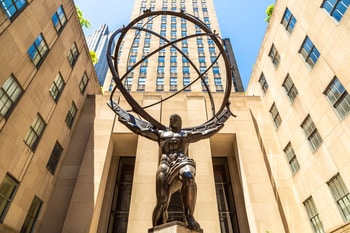
Art Deco is fairly easy to identify once you keep a few things in mind.
Art Deco style is best defined by its bold elegance, dramatic use of colors, and geometric shapes.
It embraces symmetrical designs, sleek lines, and a striking contrast between shapes and colors. Characterized by a sense of luxury and modernity, Art Deco draws inspiration from various sources, including ancient cultures, the machine age, and nature.
Intricate details and lavish materials like metals, glass, and exotic woods contribute to its opulent aesthetic.
Beyond visual elements, Art Deco embodies a forward-looking spirit of progress, often seen in its influence on architecture, fashion, and art.
This style encapsulates an era of innovation, embracing the dynamic energy of the 1920s and 1930s while leaving an enduring mark on design and culture.
What Defines Art Nouveau Style?

When it comes to Art Nouveau, think old-school mysticism, flowing curves, and dramatic shapes.
In short, Art Nouveau’s style is defined by its intricate and organic elegance. It celebrates flowing lines, asymmetry, and a profound connection to nature.
This style draws inspiration from natural forms such as flowers, vines, and insects, incorporating them into intricate designs that evoke a sense of harmony.
Art Nouveau often uses delicate pastel colors and employs materials like stained glass, ceramics, and wrought iron to create its distinctive aesthetic.
With a focus on craftsmanship and the integration of art into everyday life, Art Nouveau seeks to blur the lines between fine art and functional design.
Emerging in the late 19th century, this style reflects a reaction against the industrial age’s mechanization, embracing the beauty of the natural world and giving it just a touch of mysticism.
Can You Mix Art Deco and Art Nouveau?
Oh absolutely! I’m big on doing whatever pleases you, but the truth is that people have been integrating the two styles for decades!
Think of the ever-popular Peacock feather fans, necklaces, and earrings from the 1920s. While Peacock feathers were considered to be luxurious, they are a part of the natural world that Art Nouveau celebrates.
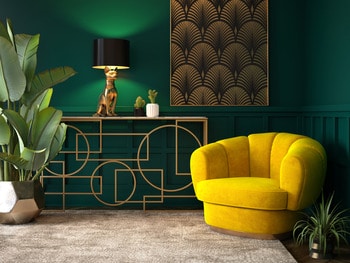
Mixing Art Deco and Art Nouveau elements can lead to a captivating blend of styles that harmonize their distinct characteristics.
While these styles emerged in different eras with contrasting aesthetics, they share a common emphasis on artistic expression and innovative design.
Integrating the geometric precision of Art Deco style with the organic motifs of Art Nouveau style can result in a unique visual look that bridges the gap between sleek modernity and ornate elegance.
Mixing these two styles can bring forth a new and exciting look into your life.
So Are Art Deco and Art Nouveau Related?
In many aspects, they are, despite their differences.
Art Deco and Art Nouveau are related in the sense that they are both influential art movements that emerged in the late 19th and early 20th centuries.
However, they differ significantly in terms of style, aesthetics, and cultural context.

Art Nouveau style, characterized by its organic and flowing forms inspired by nature, was a response to the industrial revolution of the late 19th century.
On the other hand, Art Deco Style, with its geometric shapes, sleek lines, and emphasis on luxury, emerged in the 1920s as a reflection of the modern and dynamic Jazz Age.

While they have distinct visual signatures, the two styles share a common desire to break away from traditional artistic norms and embrace new forms of creative expression.
Their coexistence in the timeline of art history showcases the evolution of artistic sensibilities and the diverse ways artists responded to the changing world around them.
Which Came First, Art Nouveau or Art Deco?
I believe I may have answered this earlier, but Art Nouveau predates Art Deco.
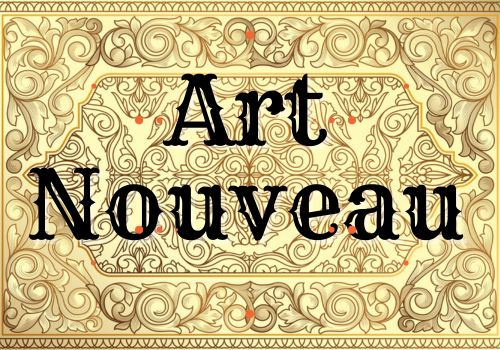
Art Nouveau emerged sometime in the late 19th century, around the 1880s or 1890s, as a reaction against the industrial revolution of the time. This art form emphasized flowing lines and organic forms inspired by nature.
In contrast, Art Deco developed in the 1920s and 1930s, drawing from diverse influences including modernism, cubism, and the machine age.
The Art Deco movement is characterized by geometric shapes, bold colors, and a feeling or sense of luxury.

While the name Art Nouveau (new art) gives us the impression that this style came afterward, the name comes from being new to the masses at that time.
Why Was the Art Deco Movement So Important in the 1920s?
The Art Deco movement held profound importance in the 1920s due to its remarkable reflection of the era’s societal shifts and cultural aspirations.
Emerging soon after World War I, art deco artists encapsulated the post-war desire for progress and modernization. With the dramatic changes that occurred in society due to this war, it only made sense that art styles should change as well.
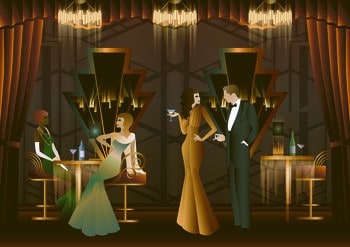
Art Deco emerged with its geometric precision, sleek lines, and bold colors in the early 1920s and it resonated with the energetic spirit of the Jazz Age, mirroring the dynamism of urban life, technological advancements, and the burgeoning consumer culture.
Art Deco design placed an emphasis on luxury and opulence, which catered to the growing middle class seeking an escape from the war’s grim reality.
Moreover, Art Deco provided a unifying aesthetic across various fields such as architecture, fashion, interior design, and the visual arts.
You can see the Art Deco aesthetic influence in iconic structures like the Chrysler Building in New York, exemplifying the fusion of artistic expression and industrial innovation.

This decorative art style also reflected the era’s interest in global exploration and fascination with ancient cultures, leading to a diverse range of design inspirations.
Ultimately, the Art Deco movement of the 1920s represented more than just a stylistic trend; it captured the spirit of an era marked by profound societal transformation and a longing for a vibrant and sophisticated future.
Why Did the Art Deco Decline in the 1930s?
The simplest answer is that the Great Depression left people with a distaste for items considered luxurious or opulent, but it’s a bit more complicated than that.
The decline of the Art Deco style in the 1930s can be attributed to several interconnected factors.
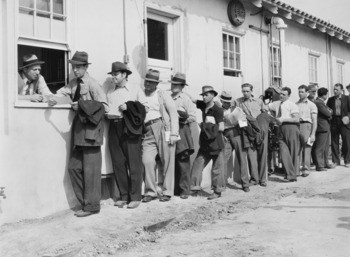
First, the onset of the Great Depression profoundly impacted economies worldwide, leading to a reduced demand for the ornate and luxurious aesthetic that defined Art Deco.
It was hard to celebrate “luxury” when people were starving.
As middle-class resources dwindled, the focus shifted from ornate designs to more economical and functional approaches.
Second, the escalating geopolitical tensions that culminated in World War II diverted attention away from artistic and cultural pursuits.
The changing social and political landscape of the late 1930s and early 1940s prompted a shift towards simpler, more utilitarian designs that aligned with the changing values of the time.
As a result, Art Deco’s extravagance gave way to the more streamlined and pragmatic design sensibilities that characterized the mid-20th century.
Despite its decline, Art Deco’s legacy endured and is still a popular design choice even 100 years later.
What Style Replaced Art Deco in the 1930s?

Slowly, over the decade of 1930s, the Art Deco style gradually gave way to the emergence of the Streamline Moderne, also known as Streamline Style.
This new design movement was influenced by technological advancements, particularly those in transportation and industrial design.
Streamline Moderne retained a few of the elements of Art Deco’s geometric shapes and sleek lines but emphasized even greater simplicity, smooth curves, and a focus on aerodynamic forms.
This new style sought to capture the imagery of speed, efficiency, and progress, reflecting the optimism and enthusiasm of the era despite the economic challenges of the Great Depression.
With a more subdued approach to ornamentation, Streamline Moderne represented a transition towards the modernist ideals that would further shape design aesthetics in the decades to come.
9 Comparative Differences Between Art Nouveau and Art Deco in Detail

My chart at the top of the article gives you a basic idea about these differences, but let’s go over them in a bit more detail.
1. Time Period:
- Art Deco: 1920s-1930s
- Art Nouveau: Late 19th century (1890s-early 1900s)
2. Style Emphasis:

- Art Deco: Geometric, sleek, symmetrical
- Art Nouveau: Organic, flowing, asymmetrical
3. Influences:
- Art Deco: Industrialization, technology, modernity
- Art Nouveau: Nature, mythology, symbolism, romanticism
4. Materials:

- Art Deco: Metals, glass, bold colors, exotic woods
- Art Nouveau: Curved lines, stained glass, ceramics, pastels
5. Motifs:
- Art Deco: Zigzags, sunbursts, streamlined forms
- Art Nouveau: Flowers, vines, insects, flowing lines
6. Architecture:

- Art Deco: Skyscrapers, streamlined buildings
- Art Nouveau: Ornate facades, decorative details
7. Jewelry Design:
- Art Deco: Symmetrical, gemstones, luxury
- Art Nouveau: Whiplash curves, enamel, artistic expression
8. Emphasis:

- Art Deco: Elegance, luxury, glamour
- Art Nouveau: Beauty, artistic expression, connection to nature
9. Legacy:
- Art Deco: Influence on design, urban landscapes
- Art Nouveau: Bridged historical and modern styles, contributed to Art Deco’s emergence
Art Deco and Art Nouveau are sisters in both modern art style and architecture.
Were There Famous Art Deco Artists?
Oh yes, there certainly were!
You may not be familiar with their names, but several renowned artists made significant contributions to the Art Deco movement.

Some of the most notable figures include Tamara de Lempicka, known for her portraits exuding sophistication and modernity, and Erté, celebrated for his elegant fashion illustrations.
René Lalique was known for his intricate glasswork, along with Cassandre‘s iconic graphic design, which also left indelible marks on the movement.
Each artist brought their unique vision to Art Deco, enriching its aesthetic tapestry and influencing its evolution as a dynamic and glamorous style during the early 20th century.
Who Were Some Famous Art Nouveau Artists?
The Art Nouveau movement was graced by the talent of several notable artists, although their names are only known now to art fans.
Among them, Alphonse Mucha stands out with his ethereal and intricate decorative illustrations.

René Lalique‘s exquisite glasswork and jewelry designs showcased the movement’s affinity for nature-inspired motifs. As the 1920s unfolded, his artistic approach underwent a transformation. Shifting away from the organic nature-inspired shapes of Art Nouveau, he embraced a more streamlined design to align with the Art Deco sensibility. This evolution led him to incorporate materials synonymous with the Art Deco era, such as sleek metal, gleaming chrome, delicate ivory, and vibrant enamel.
Lalique was famous as both an Art Nouveau and Art Deco artist!
The architect and designer Antoni Gaudí left an indelible mark with his awe-inspiring organic architecture, particularly seen in the iconic Sagrada Família in Barcelona.
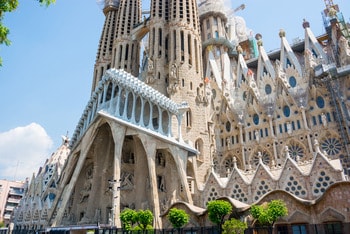
Another notable figure is Gustav Klimt, who infused his paintings with sensual symbolism and intricate patterns.
All of the above-mentioned artists, among many others, breathed life into Art Nouveau’s flowing lines and ornate forms, shaping its enduring legacy.
Final Summary
I hope you have found this article, which unveils the distinct artistic worlds of two influential movements, informative and interesting.
Art Deco, born in the Jazz Age of the 1920s, champions geometric elegance and luxury, embodying the modernity of the Jazz Age.
By contrast, Art Nouveau, emerging in the late 19th century, celebrates organic forms and the beauty of nature.
I’ve highlighted nine pivotal distinctions, from stylistic features to historical contexts. While each movement holds its unique charm, they share a common thread of reshaping artistic expression and leaving an enduring legacy in design, architecture, and culture.
Written by Kerry Wisby – GatsbyFlapperGirl.com
Owner & Founder of GatsbyFlapperGirl.com
Kerry Wisby, a former teacher with a BA in English, is the founder of GatsbyFlapperGirl.com. With a passion for all things 1920s, including The Great Gatsby novel, her website is the ultimate source for Roaring Twenties fashion, history, and party ideas. Read more about Kerry here.

















